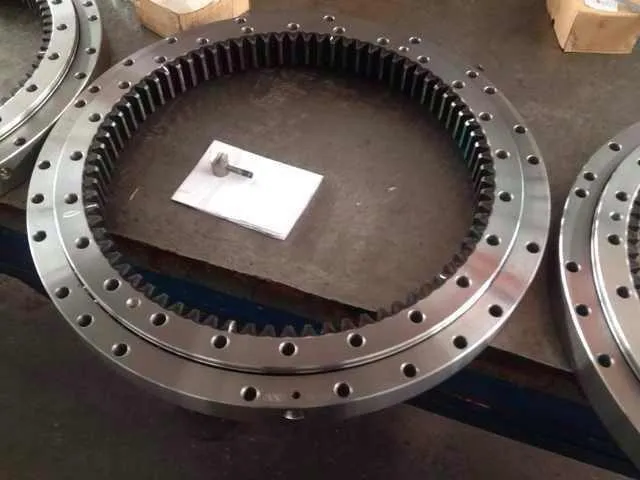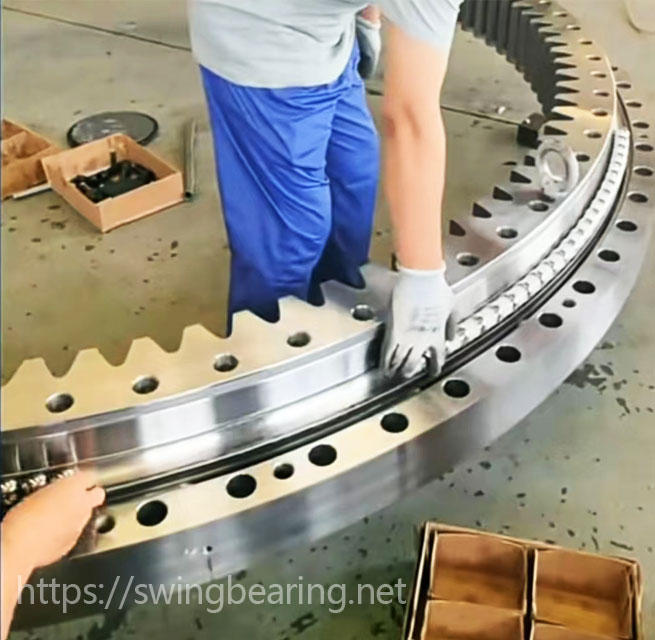
The excavator slewing bearing sealing ring is a critical component that plays a significant role in the overall operation and maintenance of the machine. Ensuring its proper function is essential for preventing hydraulic oil leakage, protecting the support system, ensuring safe operation, and reducing maintenance costs. This comprehensive guide will walk you through the process of replacing the excavator slewing bearing sealing device, providing detailed steps and important considerations.
The slewing bearing sealing ring in an excavator is essential for maintaining the integrity of the hydraulic system and protecting vital components. It prevents hydraulic oil leakage, which can lead to a drop in system pressure, affecting the machine’s performance and potentially causing damage. Additionally, the sealing ring protects the support system from debris, moisture, and other external substances, extending the lifespan of bearings and gears. Ensuring the proper installation and maintenance of this sealing ring is crucial for the safe and efficient operation of the excavator.

The slewing bearing supports the entire body of the excavator and operates through a hydraulic system. The sealing ring ensures that hydraulic oil circulates within the support system and does not leak into the external environment. Hydraulic oil leakage can lead to a drop in system pressure, compromising the machine’s performance and potentially causing damage.
The sealing ring prevents debris, moisture, and other external substances from entering the support system, protecting critical components such as bearings and gears from wear and corrosion. This protection extends the service life of these key parts.
Hydraulic fluid leakage can create slippery surfaces around the excavator, increasing the risk of operator slips or machine instability. By keeping the hydraulic system sealed, the sealing ring helps ensure the safety and stability of the excavator during operation.
A properly functioning sealing ring reduces maintenance costs by preventing hydraulic oil leakage, thereby eliminating the need for frequent oil top-ups and reducing the wear and tear on internal hydraulic system components caused by insufficient lubrication.


Proper replacement and maintenance of the excavator slewing bearing sealing ring are crucial for ensuring the machine’s performance, safety, and longevity. By following the detailed steps outlined in this guide, operators can prevent hydraulic oil leakage, protect vital components, and reduce maintenance costs, ensuring efficient and safe operation of their excavators.
The excavator slewing bearing sealing ring is a crucial component that plays an essential role in the performance and longevity of the excavator. Proper maintenance and timely replacement of this component can prevent hydraulic oil leakage, protect critical parts, ensure safe operation, and reduce maintenance costs. This blog will provide detailed steps for replacing the slewing bearing sealing device, highlighting its significance and offering practical advice for maintaining your excavator in optimal condition.
The slewing bearing supports the excavator’s body and operates through a hydraulic system. The sealing ring ensures hydraulic oil circulates within the system, preventing leakage. Hydraulic oil leakage can lead to a drop in system pressure, compromising performance and potentially causing damage.
The sealing ring prevents debris, moisture, and other external substances from entering the support system. This protection extends the service life of critical components such as bearings and gears by preventing wear and corrosion.
Hydraulic fluid leakage can create slippery surfaces, increasing the risk of operator slips or machine instability. By maintaining a sealed hydraulic system, the sealing ring helps ensure the safety and stability of the excavator during operation.
A properly functioning sealing ring reduces maintenance costs by preventing hydraulic oil leakage. This eliminates the need for frequent oil top-ups and reduces the wear and tear on internal hydraulic system components caused by insufficient lubrication.
Proper replacement and maintenance of the excavator slewing bearing sealing ring are crucial for ensuring the machine’s performance, safety, and longevity. By following the detailed steps outlined in this guide, operators can prevent hydraulic oil leakage, protect vital components, and reduce maintenance costs, ensuring efficient and safe operation of their excavators.
The replacement frequency of the slewing bearing sealing ring largely depends on the usage and operating conditions of the excavator. It is crucial to conduct regular inspections to detect signs of wear or damage early. Typically, heavy usage in harsh conditions may necessitate more frequent replacements, while lighter usage in controlled environments might extend the interval. Operators should adhere to the manufacturer’s guidelines and consider factors such as operating hours, load intensity, and environmental conditions. Keeping a maintenance log and performing periodic checks can help in making informed decisions about when to replace the sealing ring to ensure optimal performance and avoid unexpected breakdowns.
Signs of a failing sealing ring include hydraulic oil leakage, which can lead to a drop in system pressure and reduced performance. Additionally, abnormal noises or vibrations during operation can indicate issues with the sealing ring. Visual inspections might reveal wear, cracks, or other damage to the sealing ring. In more advanced stages of failure, you may notice contamination in the hydraulic oil or increased wear on adjacent components, indicating that the sealing ring is no longer providing adequate protection.
While replacing the sealing ring is a task that some may choose to undertake themselves, it is generally recommended to hire a professional unless you have the necessary tools, skills, and experience. The process requires precision and care to avoid damaging the support base or other critical components. Professionals have the expertise to ensure proper installation and can perform the task efficiently, reducing the risk of errors that could lead to further issues. If you decide to do it yourself, ensure you follow detailed guides and have a thorough understanding of the process to avoid potential damage.
It is essential to use the lubricant recommended by the excavator’s manufacturer for the sealing ring. The recommended lubricant is specifically formulated to be compatible with the materials of the sealing ring and the operating conditions of the excavator. Using the correct lubricant helps ensure optimal performance, reduces wear, and extends the lifespan of the sealing ring and other components. Always refer to the operator’s manual or consult with a professional to determine the best lubricant for your specific excavator model.
To extend the life of your excavator’s slewing bearing sealing ring, it is crucial to follow a regular maintenance routine. This includes periodic inspections to detect signs of wear or damage early, proper lubrication using the recommended lubricant, and ensuring that the sealing ring is installed correctly. Avoid overloading the excavator and operating it under extreme conditions whenever possible. Additionally, keeping the work area clean and free of contaminants can prevent premature wear. By adhering to these practices, you can significantly extend the lifespan of the sealing ring and maintain the excavator’s overall performance.